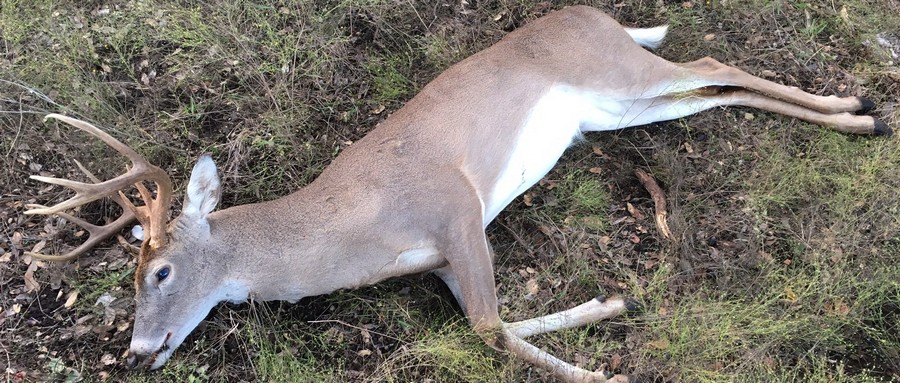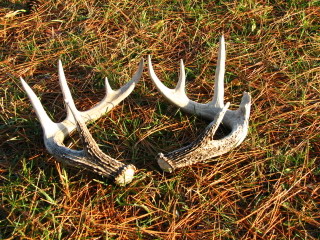With the General Hunting Season in Texas at about the half-way point, many hunters have already filled the freezers and have focused on other activities. For those hunters that have yet to bag the big one, the recent cold front we received at the first part of December has created excellent hunting weather. For one East Texas hunter, we will refer to as Paul, the last weekend proved to be a dandy.
With approximatley 500,000 white-tailed deer harvested each year in Texas, it takes many days in the field to put that many deer on the ground. Hunting is not only a part of our natural heritage, but a means to keep Texas’ white-tailed deer population in check. Deer population numbers over much of Texas continue to exceed optimal deer densities. Keeping deer numbers in check with available habitat means better body conditions, better antler quality, and better fawn crops.

However, harvesting deer and keeping numbers down is not as easy as you think. It takes time, money, and hard work. Each year, hunters pump millions of dollars into small town, local economies. Everything from gas, food, and hunting supplies keep many of these small town businesses up and running. Hunters help boost local business, help control deer numbers, and take home some good eating at the same time.
Paul, your above average, gung-ho, Texas hunter lives by the motto “bag ’em and tag ’em, sack ’em and stack ’em.” He realizes that his efforts to control deer numbers are all part of his overall management plan to improve the deer herd found on his hunting lease. “When I see bucks that I don’t want breeding back into the population, I take ’em out,” Paul stated to me in an exclusive interview.
Deer Herd Management
Paul and his hunting buddies do their best to manage the deer population found on their 650-acre hunting lease in Bell County, Texas. Managing all segments of the deer population is critical to their overall plan. This past Friday, Paul managed to remove a cull buck from the local population. “I saw this monstrous spike walk out that needed shootin’ and I had an itchy trigger finger, so I dropped the hammer,” Paul said after harvesting the spike.
By removing this spike, Paul ensured that the genes of this inferior yearling buck will not be passed on into the remaining population. However, the management plan on this Texas ranch also includes removing unwanted middle-aged bucks and some older, mature bucks. The overall buck management strategy on Paul’s lease includes removing bucks at least 3 1/2 years of age with 8 or fewer points and harvesting bucks with 9 or more points at 5 1/2 years of age. The plan also includes removing bucks, regardless of age, with unwanted antler characteristics.
Buck Harvest Rates
Under a quality buck management program, buck harvest should be limited to removing no more than 20 percent of the buck herd on a property in any one year. This ensures that mature bucks will be available to harvest in the future. However, as previously stated, this overall harvest number includes undesirable young bucks, middle-aged bucks, and, of course, mature bucks that have reached their overall genetic potential.
The Friday morning following Paul’s spike harvest, he also managed to bag a nice 9 point white-tailed buck. Paul said while cleaning the healthy buck, “I didn’t like the way the tines were arranged, and I don’t want those genes on my end of the lease, so I dropped the hammer.” The buck also ended up being the best buck that Paul had ever harvested.
Remember, it takes the harvest of a lot of undesirable bucks to get better bucks on your property. As mentioned, managing a deer population is not an easy job. Managing populations is done on a state level and county level in Texas with general hunting regulations, but what happens on your property is up to you. Deer management is done on the property level with hunters having options within the general regulations of what they actually want to harvest on their particular piece of property.
Management Means Harvest of Bucks… AND Does
The work doesn’t end after the shot. It’s not just a photo shoot. Actually, after the harvest is when most of the work begins. Make sure to take proper care of your game for best table fare. Immediately after his kills, Paul field dressed both of his bucks and made sure to cool them properly. Afterwords, since Paul chose not to process these particular animals himself, it was time to head to the local deer processing facility. Although Paul’s transportation method was not typical, it definitely did work. Of course, if you ever have the chance to meet Paul, you’ll soon realize he’s not your typical hunter.
Managing deer on your property is not just about shooting bucks. It also involves proper harvest of the doe segment of your population and maintaining deer numbers at the proper density for the habitat on your property. Paul has managed to bag two does already this season, and with one more left to harvest, you can bet he’ll be gaining weight this winter! Break out the steaks and some hot grease (no trans fat of course).

